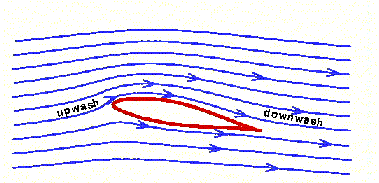 Air
is at rest, but when our wing approaches, a force acts on the air. We will see a
bend in the airstream (up-wash in the drawing). The air goes up. Newton's
third law states "for every action there is an equal reaction".
Air
is at rest, but when our wing approaches, a force acts on the air. We will see a
bend in the airstream (up-wash in the drawing). The air goes up. Newton's
third law states "for every action there is an equal reaction".How does a wing really work?
Concerning the wing, the use of Bernoullis law is largely wrong.
How the wing works can be explained with mathematics, but that is a matter of complicated formulas and of course computer programs.
On the previous page you could read how an
airstream along the underside of a wing creates lift. That is the
physical explanation
and uses the laws of the great English physicist Isaac Newton.
Newton’s first law states: a body at rest
will remain at rest, or a body in motion will continue in straight-line motion
unless subjected to an external applied force.
 Air
is at rest, but when our wing approaches, a force acts on the air. We will see a
bend in the airstream (up-wash in the drawing). The air goes up. Newton's
third law states "for every action there is an equal reaction".
Air
is at rest, but when our wing approaches, a force acts on the air. We will see a
bend in the airstream (up-wash in the drawing). The air goes up. Newton's
third law states "for every action there is an equal reaction".
An example: if I put a stone on a table, the stone
puts a force on the table (the weight of the stone).
The table puts at the same time a force on the stone (strange, but true....)
Back to the wing. To obtain lift, the wing has to do something with the air. That is action (up-wash). The lift is the reaction (down-wash). It is important the wing has an angle with the horizontal. This is called the angle of attack.
The wing exercises a force on the air, which was
first at rest. That force depends on the speed and the mass of the air. An
aeroplane flies fast to very fast. So the wing reflects large quantities of air.
The lift of a wing is equal to the change in moment of the air it reflects
downwards. Moment is a product of mass and speed. The lift of a wing is equal to:
the quantity of air reflected downwards times
the downward speed of that air
To provide a wing with more lift:
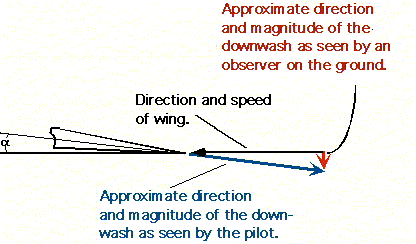 The
illustration left shows the downward stream of air as seen by the pilot and an
observer on the ground.
The
illustration left shows the downward stream of air as seen by the pilot and an
observer on the ground.
For the pilot it seems the air comes sloping from the wing, in the same
direction as the wing's angle of attack.
After all, for the pilot the wings seems motionless.
An observer on the ground would see the air coming from the wing almost
vertically. The larger the angle of attack, the larger the vertical speed of the
air. Until a certain angle of attack. If that angle is too large, the airstream
detaches and the wing loses lift. The wing is stalled. The nose of the
aeroplane dives and most of the time it banks to the left or right.
We all know the downward speed of a wing very well:
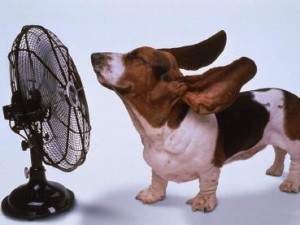 |
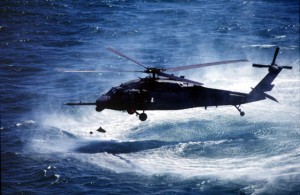 |
| The ventilator consists of little
wings which are attached to the axe at an angle. They turn fast. By this reaction the airstream is perpendicular to the little wings. |
An other ventilator, the Pavehawk.
The rotor blades are little wings in an angle, turning rapidly around. The airstream is deflected vertically. Just look at the water... |
So the wing is in reality a giant air-pump and the
air pumped downwards keeps the aeroplane in the air because of the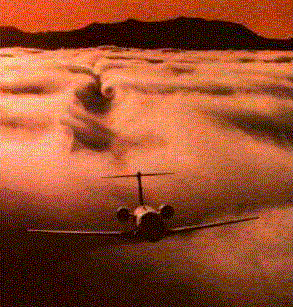 lift. If it would fly over a giant balance, it would show the weight of the
aeroplane. You can see the effect on the not so perfect photo on the right. A
small jet overflies the fog in a valley. By the airstream downwards it leaves a
trail in the fog. The fog curls up. This is caused by the vortex of the wingtips.
lift. If it would fly over a giant balance, it would show the weight of the
aeroplane. You can see the effect on the not so perfect photo on the right. A
small jet overflies the fog in a valley. By the airstream downwards it leaves a
trail in the fog. The fog curls up. This is caused by the vortex of the wingtips.
Thanks to the Allstar Network
This Youtube movie shows a landing Airbus A320 blowing away the fog, so the runway becomes visible:
http://www.youtube.com/watch?v=ApvmNZwUbzM